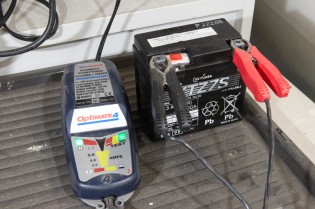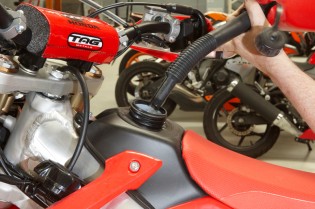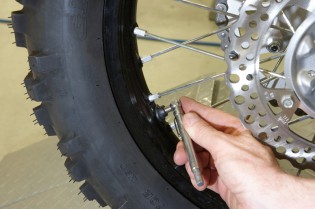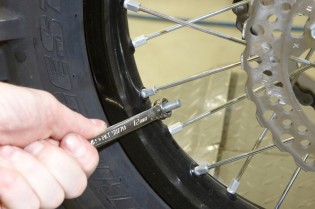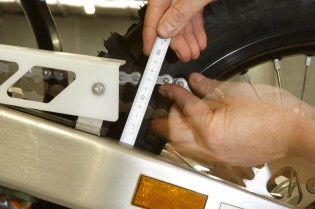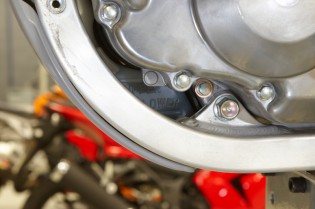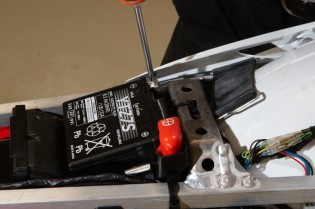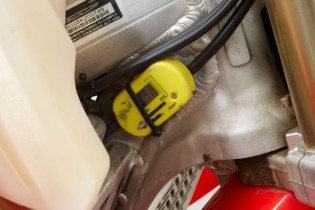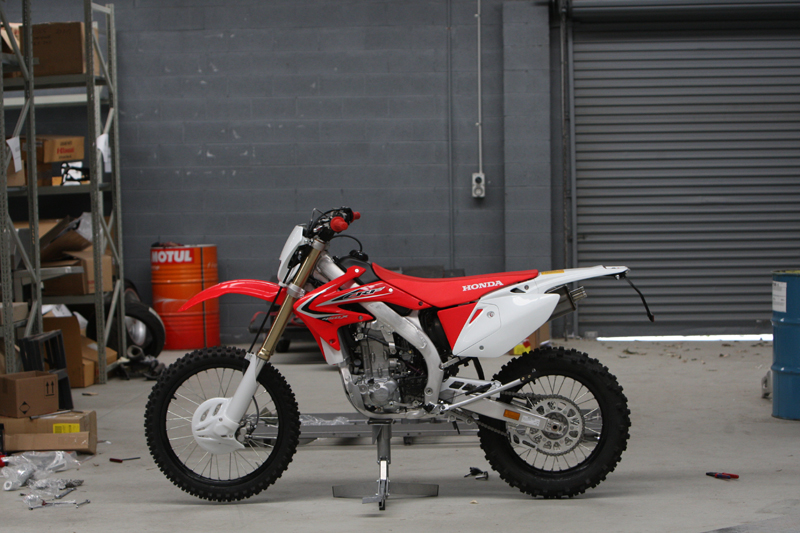
Your brand-new ride is released from the crate, but is it ready to ride now? No? It needs to be “Wet Up”?
Assembling the bike out of the crate is the first step at the dealer. The next step is just as important. This is the Pre Delivery or “Wet Up” stage, where checks are made and adjustments take place, so by the time you hand over your coin, it is ready to ride
STORY & PHOTOGRAPHY BY MAX SULLIVAN
CHARGED UP
Not every new bike has a battery, and not every battery actually needs a charge. However, some batteries come without the electrolyte, which has to be poured into the battery and the battery charged prior to starting the bike. Maintenance-free batteries often come ready to go, however a top up with a quality battery charger prior to putting the battery into service is always a good thing. If the voltage is too low, the battery may not start the bike and in some cases, never offer a good service life.
ROCKET FUEL
Most good bike dealers deliver the bike to you with a full tank of fuel. Hopefully they use a good-quality fuel and correct octane rating for the engine. For carburetted motorcycles I prefer to pour fuel in prior to starting the pre-delivery sequence as it gives the fuel time to settle in the carburettor and dissolve/mix with some of the old fuel still found in the float bowl. Just remember to turn the fuel tap on as soon as the fuel tank is full to allow time for the fuel to mix.
CHUNKY BITS
You can drain the carburettor using a screwdriver and the drain screw on the bottom of the float bowl, however I prefer to remove the access bung on the bottom of the bowl. This often has sediment and foreign particles in it that have settled over time. Old fuel often starts to solidify in here, since every bike is started at the factory and some fuel residue remains inside the carburettor as the bike begins its long trip from Japan to Australia. Give the bung a good clean and wipe out with a rag if necessary.
LOW-PRESSURE ZONE
The tyres are fitted and pumped up at the factory, but as we all know, they will decrease in pressure over time. The tyre pressure needs to be checked and adjusted. Don’t expect the technician to know exactly what pressure you like to run, so always check it prior to riding the bike yourself. After removing the tyre pressure gauge, place a little spit (yes from your mouth) on the tyre valve to ensure it does not have a slow leak. Any leak from the valve will quickly show by a bubble forming on the valve stem.
WHEEL MAN
The next thing to check on the wheels is the spokes. Use a spoke spanner to go around the wheel and tension each spoke. Do this evenly and rotate the wheel several times if necessary to cover all spokes and obtain the right tension. While you are there, grab a spanner and check the tension on the rim locks. Don’t over-tighten them as they can pull the stud out of the alloy body of the rim lock.
FEEL THE TENSION?
Chain tension is also checked at pre-delivery. It should be correct but is always worth a second look. The manufacturer’s manual is referred to for each model as different bikes have the chain tension checked in different ways. Some simply take one measurement from the top or bottom of the swing arm, while others check free play by measuring the difference between pushing down and pulling up on the chain. Also check the chain adjuster indicators on each side of the swing arm to ensure the wheel is straight.
SLIPPERY STUFF
The CRF comes with engine oil already in the engine. A mineral-based oil is used so the engine can run in correctly. The level still needs to be checked. An initial check is done cold, prior to starting the bike, just to ensure no one has forgotten to put it in. After the engine is warm, the correct oil level is checked and adjusted if necessary. Don’t be tempted to put in the latest synthetic oil until the engine has run in or you can create problems.
SEPARATE BOX
Not every engine has separate gear box oil, but it is becoming more popular. It is a great idea to keep gear box contaminants from entering the engine. The down side is that both compartments run a small amount of oil. The gearbox has no dipstick, but it does have an inspection plug. Unscrew the plug and make sure oil starts to weep out when the bike is on both wheels and upright. Again, it is a good idea to check it prior to starting the bike then do a final check with a warm engine.
KEEP YOUR COOL
Once again, the bike should arrive from the factory with coolant in the radiator. The radiator cap should be removed and the coolant level checked when the bike is cold. A moto cross bike with no overflow bottle will have a small air gap at the top of the radiator, but the coolant should cover the cores. If an overflow bottle is fitted, check the coolant level in there as well. When the engine is hot, the level should be at the high mark.
POWER UP
Hopefully by now, the battery charger is indicating full and it is time to fit the new battery. It is best to let the battery cool for 30 minutes prior to fitting to the bike. Fit the red positive cable first. This is the danger terminal and if your screwdriver touches the frame, it will not cause a spark since the black negative cable is not yet fitted. Once secure, move onto the black negative cable and fit the lead to the battery. Now it is time to fire up and run through some more tests.


